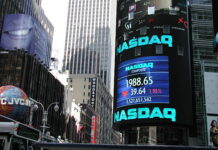Wall Street closed higher on Wednesday, reversing previous losses. Equities reacted to increased hopes that the Congress would reach consensus on further stimulus, as talks continue. Still, the focus is on a new relief package instead of Democrats’ $2.4 trillion stimulus proposal.
On top of that, markets reacted to upbeat economic data, as ADP’s employment report showed that private payrolls rose 749,000 jobs in September after rising 481,000 in the previous month. Analysts anticipated an increase by 650,000. Still, the rise in employment might be capped by the accelerating spread of the coronavirus. Elsewhere, the National Association of Realtors said that its Pending Home Sales Index surged 8.8% to a record high of 132.8 in August, beating all expectations by a margin.
Tech stocks were not the main driver at this time, as the market was boosted by healthcare, financials, consumer goods and basic materials. Dow Jones was the best performer, securing a 1.20% gain. The S&P 500 and Nasdaq rose 0.83% and 0.74%, respectively. 10 of the S&P 500’s 11 main sectors ended higher.
While all three benchmark indexes declined in September, they ended the third quarter in positive territory, with the S&P and Nasdaq experiencing best two-quarter winning streaks in many years.
Equities have consolidated their bullish stance after US Treasury Secretary Steven Mnuchin hinted to progress in stimulus talks, though he admitted he hadn’t reached an agreement with House Speaker Nancy Pelosi on the proposed $2.4 trillion package. Instead, after the markets closed, the media reported that Mnuchin made a counteroffer by proposing a $1.6 trillion stimulus package. Still, Senate Majority Leader Mitch McConnell said that Republicans and Democrats remain far apart in their negotiations.
In Asia, stocks are mostly bullish on Thursday, but the trading volumes are very low as several markets are closed.
Japan’s Nikkei 225 is up 0.48%, but trading was suspended for the whole day as the Tokyo Stock Exchange experienced its worst technical glitch in history. Investors are frustrated and not sure when trading will resume. After Nikkei’s worst decline in two months on Wednesday, investors hoped to buy back shares amid the bullish impulse from US stocks. However, they can’t do it as trading was halted.
Markets in China are closed for the Mid-Autumn Festival. Trading is also closed in Hong Kong and South Korea, as the two countries celebrate National Day and Full Moon Festival, respectively.
In Australia, the S&P/ASX 200 index is up 1.09%. Job vacancies surged 59.4% in the three months to August, after tumbling by over 43% in the March-May period. The labor market is recovering as the government is easing restrictive measures.
European stocks will follow the general bullishness and will open higher, judging by the current performance of index futures.
In the commodity market, oil prices are mixed but steady on Thursday, as renewed hopes for US stimulus are supporting the market. However, the persistent worries about fuel demand are putting pressure. At the time of writing, WTI is down 0.15% to $40.45 but Brent is up 0.57% to $42.55. The market reacted positively after the Trump administration came with the counteroffer on new stimulus.
The stimulus talks have bolstered interest in gold as well, with the metal benefiting from a weakening US dollar. Gold is now up 0.37% and has just broken above the $1,900 mark again after doing so yesterday.
In FX, the US dollar fell to weekly lows as investors are selling fiat amid increased hopes for more stimulus. The USD Index is down 0.26% to 93.690. EUR/USD is up 0.28% to 1.1751. The greenback fell on upbeat economic data as well, as investors are interested in investing their cash in the economy.
The Australian dollar is the best performing currency among majors. The Aussie is supported by labor market data and the easing of coronavirus restrictions.
The euro is up against the USD, but it may suffer in the longer-term, as the European Central Bank said it might adopt a Fed-like average inflation targeting measure that would see interest rates close to zero for much longer.
The British pound is down against both the USD and the euro amid Brexit talks uncertainty and stricter lockdown.











